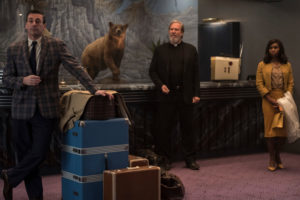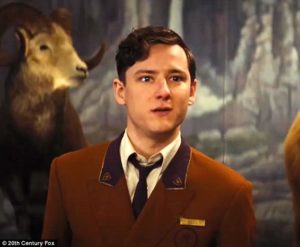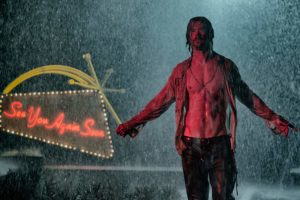Drew Goddard crafts tales that are multi-layered and philosophically challenging. From his days in the Whedon-verse to the deliciously exercise in meta-text, CABIN IN THE WOODS, there is always much more going on than the surface narrative. And so it is with BAD TIMES AT THE EL ROYALE, which may not be the flawless wonder that was CABIN, but still has much to recommend it.

Jon Hamm, Jeff Bridges, Cynthia Erivo
It could easily be the start of a horror film, the way seven strangers all find themselves coming together at virtually the same time at a mountain resort well past its prime, the titular El Royale. They are a quirky bunch that could be a distillation of America in the late 60s, when the story takes place. One by one, each of them is revealed as something other than what they appear to be, and the general confusion that ensues, during an evocatively driving rainstorm, turns from eccentric neo-noir to metaphor for a country in turmoil and the struggle for redemption.

Lewis Pullman
The arc begins with the heightened reality of the bubbly Technicolor romps of the early part of that decade, becoming grimmer and more deadly as the color palette becomes subdued, and misunderstandings between the guests and between them and their slightly twitchy wisp of a host, Miles (Lewis Pullman). There is a nice symbolism to having the El Royale straddle the state line between California and Nevada that plays well into the duality that each guest brings. They include Father Daniel Flynn (Jeff Bridges) a grizzled priest with an iffy memory; Laramie Seymour Sullivan (Jon Hamm) a southern vacuum-cleaner salesman with oblivious political incorrectness to his flowery way with words, particularly towards Darlene Sweet (Cynthia Erivo), the struggling singer with the voice of an angel and a soul downtrodden by the business she has chosen. Arriving on the heels of the others is late arrival Emily Summerspring (Dakota Johnson), decked out in attitude, crochet and leather fringe to bring the counter-culture blazing into the action and an expletive by way of registration in the guest book. The waif of a flower child (Cailee Spaeny) that appears soon after serves to complete the social landscape, and, with the purest of intentions, make matters even more.
Goddard’s twists render their intended surprises, while also confirming the rot at the core of those troubled times. He doesn’t just throw in J. Edgar’s twisted machinations, or the horror of Vietnam, or the way the strong prey upon the week on both sides of the cultural divide, he also gives us characters that are more than mere symbols. Couple that with seriously compelling performances that seamlessly transition these people as their secrets are revealed while illustrating the cultural points that Goddard is making, and you have the makings of an engrossing thriller punctuated with gunshot blasts and tidy conundrums about both right and wrong and about innocence and guilt.

Chris Hemsworth
It is the third act where things become sluggish. The crisp pacing stops a little too long with the appearance of a charismatic guru (Chris Hemsworth), who is clearly meant to evoke one of the more lurid touchstones of the late 60s. It is then that the neo-noir takes a turn into the gloriously tacky exploitation films if the era (Roger Corman’s oeuvre comes to mind) and begins to overstay its welcome.
The tension and suspense of BAD TIMES AT THE EL ROYALE, told in overlapping vignettes that make them even more nerve-wracking (in the best possible way), are effective, but so are its smaller moments of even greater import. When Darlene, rain-soaked and confounded on every level by what is happening around her, quietly slips off her wig to reveal the Afro that she will wear for the rest of the film, it is paradigm-shifting moment for her, and one of unexpected empowerment. This is a film rife with such moments that boom loud with their thoughtful implications the way guns blast and glass shatters with the chaos of tunnel vision. If it’s not Goddard’s best film, it’s certainly his most ambitious.
Your Thoughts?